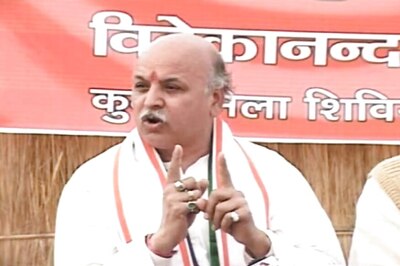
views
window._taboola = window._taboola || [];_taboola.push({mode: 'thumbnails-a', container: 'taboola-below-article-thumbnails', placement: 'Below Article Thumbnails', target_type: 'mix' });Latest News
Prof Ganjam Venkatasubbaiah, popularly known as GV, a former professor of Kannada and a lexicographer, who has edited the modern Kannada dictionary — a 9,000-page, 8-volume work — turned 100 on August 23. His is a household name in the state and if anybody doesn’t know the meaning of any complex Kannada word or face difficulty in finding that in general dictionaries, they refer to his Klishta Padakosha (a dictionary of complex words). He is also a writer of repute and has penned some books in Kannada and English.
Igo Kannada, his column in Kannada newspaper Prajavani was popular f o r 18 long years. In an interview, the grand old man of Kannada letters spoke to Express at length about his 100 years, Kannada language, literature and more.
Excerpts:
I am excited to be 100 years old… But really I don’t feel I am 100 years old because I interact with younger generation. They are all 20-30 years or even much younger than me. I share their thoughts and enthusiasm. My attitude towards life is that of a young man. The 100 years are in my genes. My mother lived for 107 years and my maternal uncle lived for 103 years and my father also lived a long life.
Kannada language is still growing… Language has the quality of growing and it changes in every 30 years. Kannada is 1,500 years old. We have primitive, old, medieval and modern forms of the language. There was a renaissance of Kannada literature in the last century. A great body of work was produced in the form of novels, stories and poems during this time. D R Bendre, Pu Thi Narasimhachar and K V Puttappa enhanced the glory of Kannada. Contemporary Kannada has more spoken words in it. Nowadays, we have more of fiction than of poetry. Our literature can be compared with the best works of any other language today. It is still in a transition
mode. Many new words have come into Kannada in the last 10 years. Young writers have introduced a new style. They use many English words and spoken words, as the importance is to keep it simple.
Our dictionary work was a big leap from Kittel’s Dictionary… It was the first our own dictionary. This work is
a modern monolingual historical etymological and encyclopaedic dictionary. It is possible to produce bilingual and trilingual dictionaries with the help of this dictionary. No other language in South India has such a dictionary. We followed the model of Oxford Dictionary. As language goes on changing, dictionaries have to accommodate changes, both in form and content. (German missionary and lexicographer Rev Ferdinand Kittel
brought out the first Kannada-English Dictionary in 1894)
Kannada Sahitya Parishat should take up an in-depth study of the status of Kannada... Comparative estimation
of harm done by other languages and ways and means to prevent inroads onto Kannada area should be done (Kannada Sahitya Parishat, the representative body of all Kannada speaking people, was established
in 1915). Kannada is a powerful language… Five crore people are speaking it. There are 10,000 languages in the world and Kannada stands in the 30th position. Such a language cannot die. Today, Kannada is a classical language and the funds given by the Centre should be used properly.
Education should be made Kannadaoriented. Books must be written more efficiently and Kannada teachers must be trained properly to teach the language to the students.
It is wrong to think that English gives you jobs… English medium is a misnomer. It never gives the knowledge
of English as a language. I want English medium to be removed and everything should be taught in Kannada. English should be taught as a language. It is only then that the real English comes to use. It is wrong to say today’s children don’t read or write as they might be involved more in other activities. This phase is not
going to be permanent. But teachers must guide them in the right path.




















Comments
0 comment